
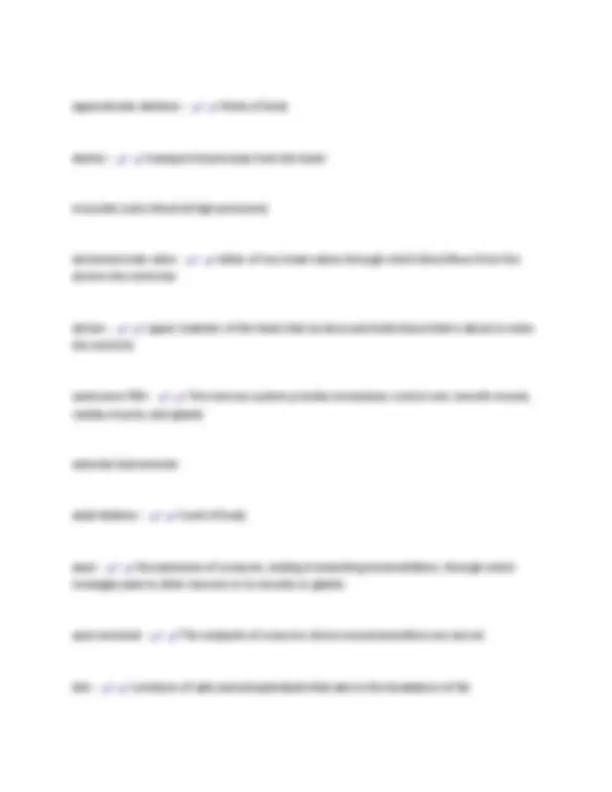
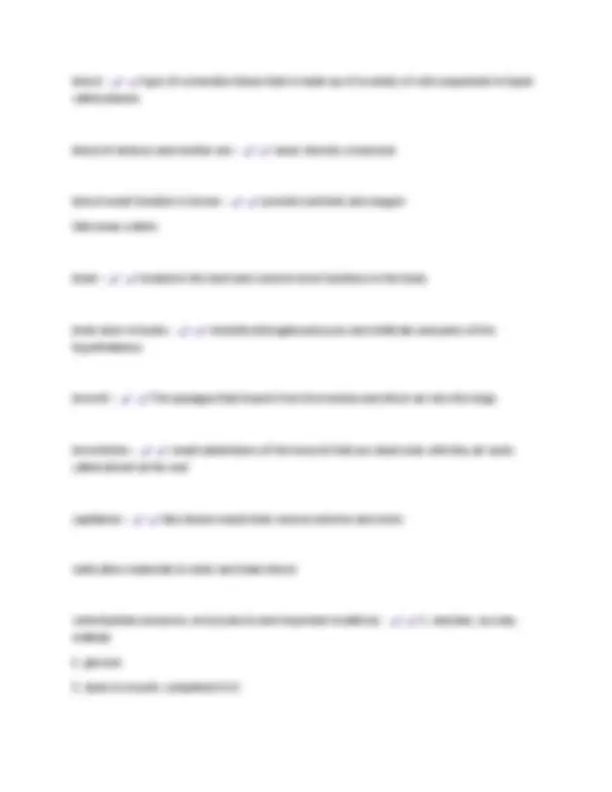
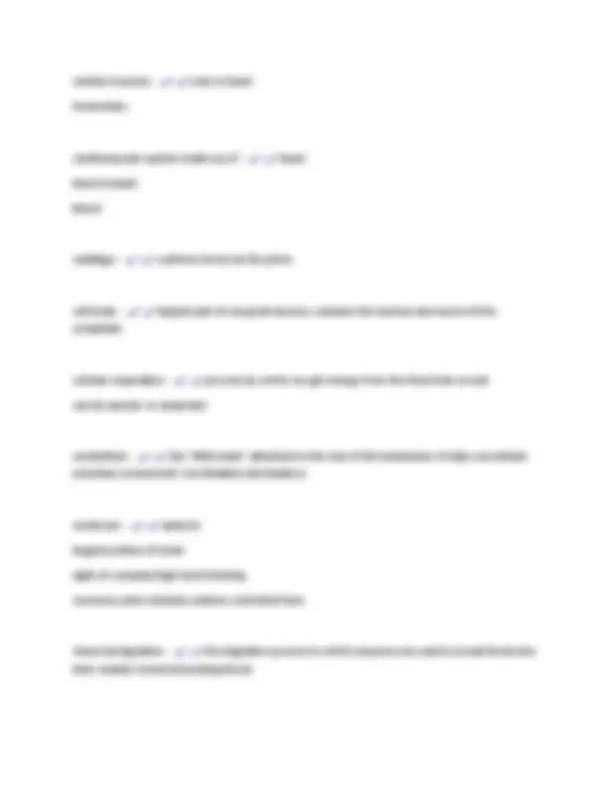
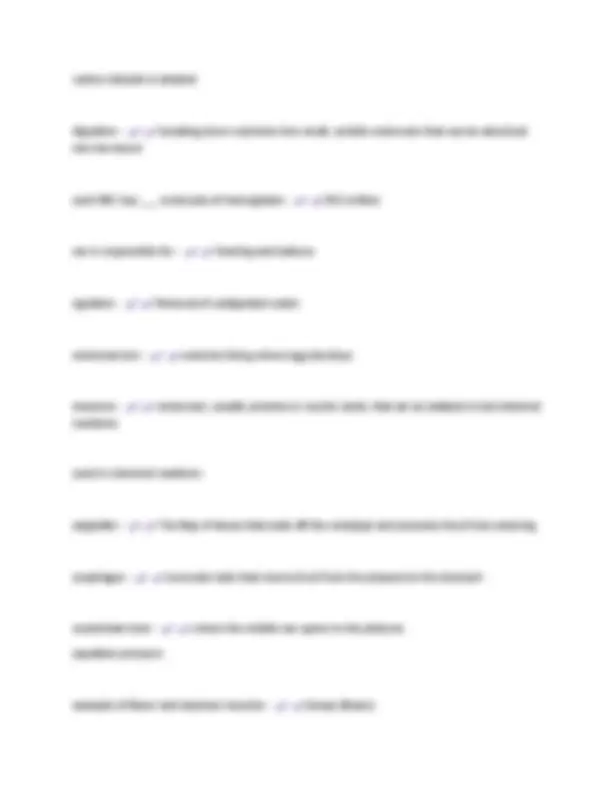
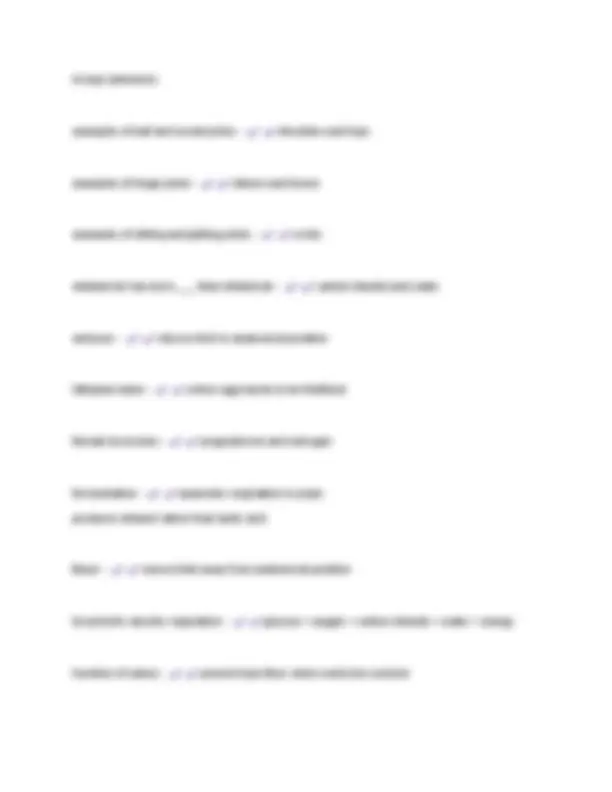
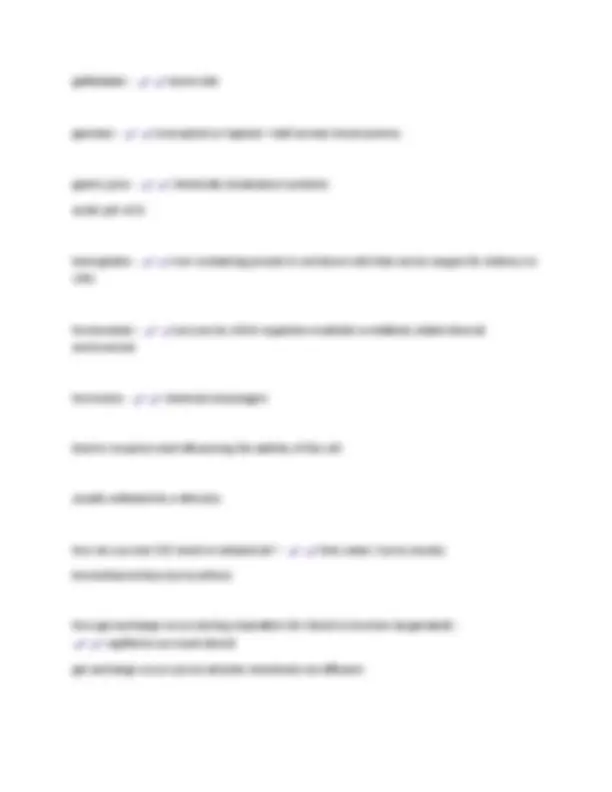
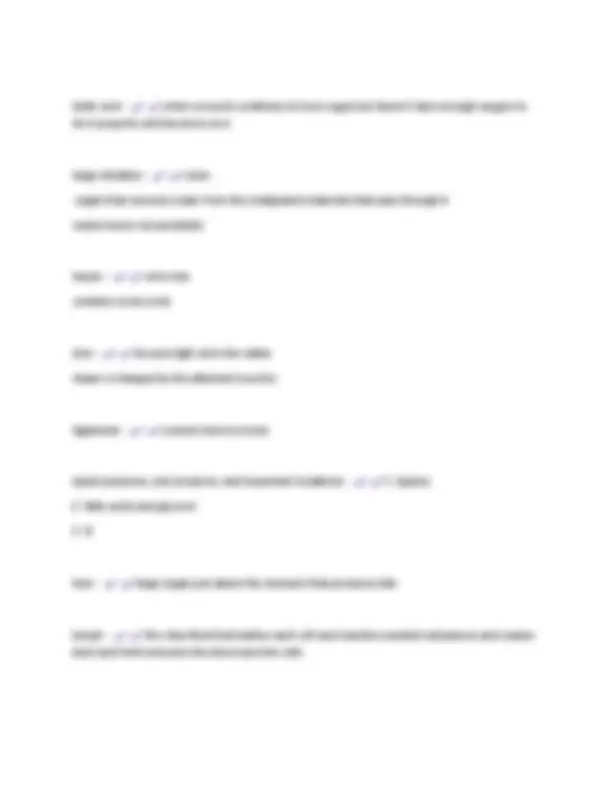
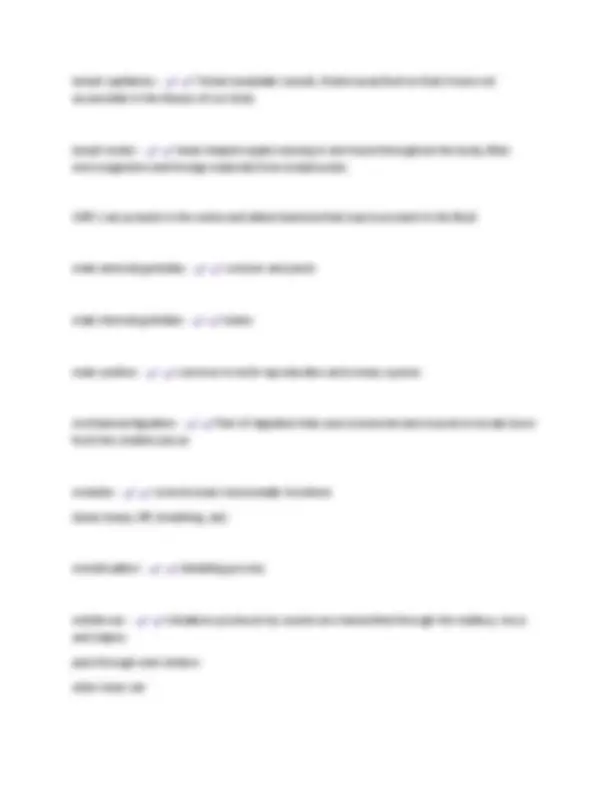
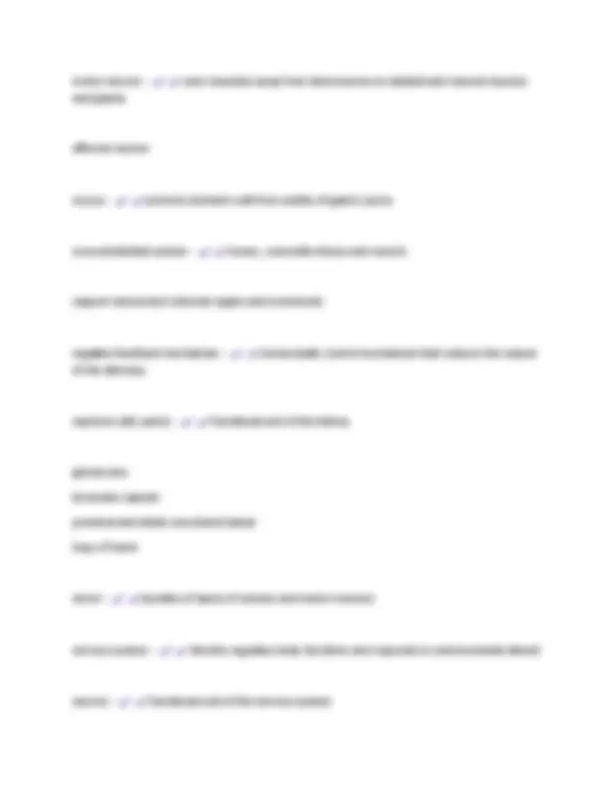
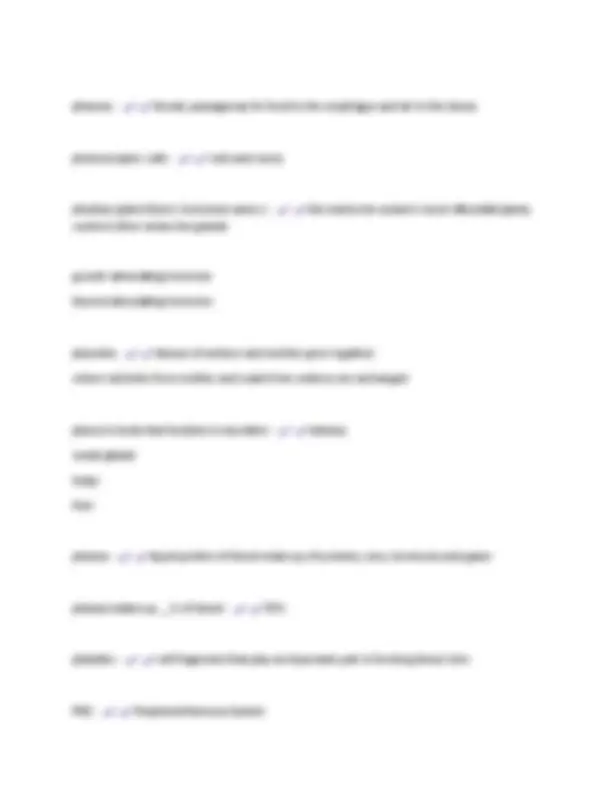
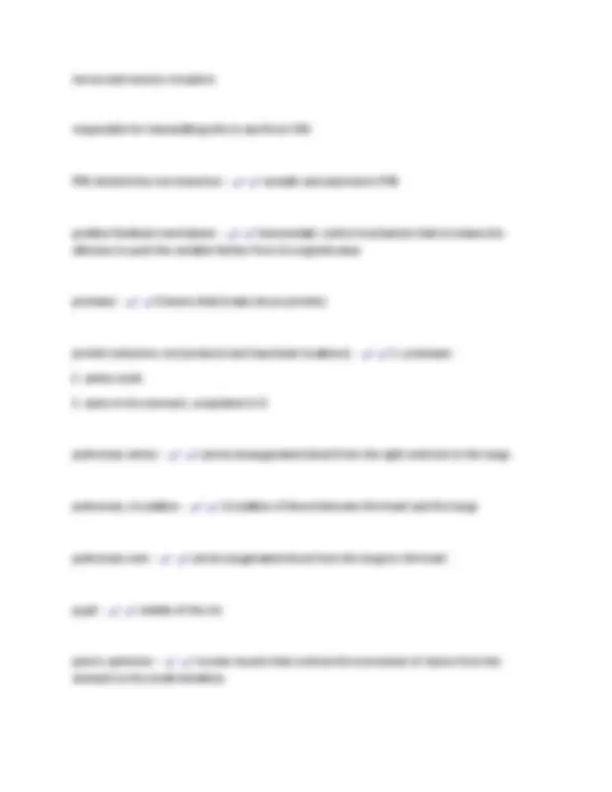
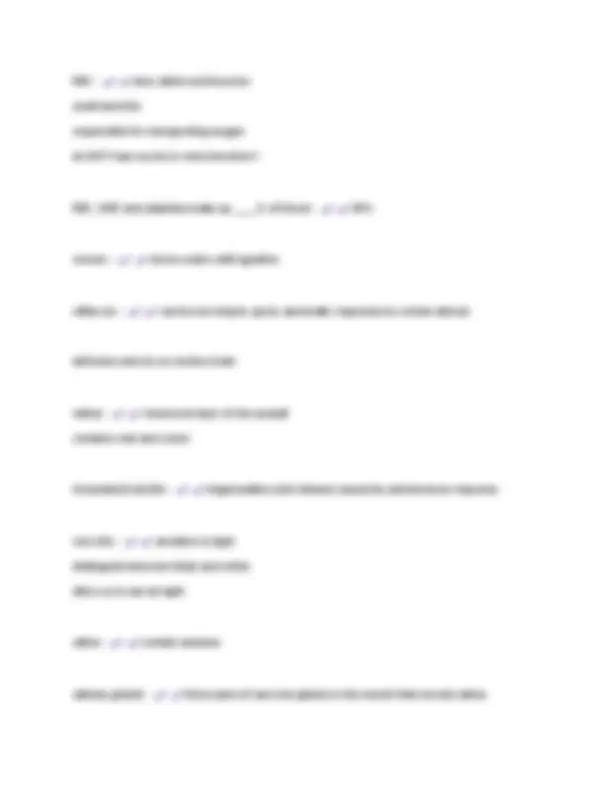
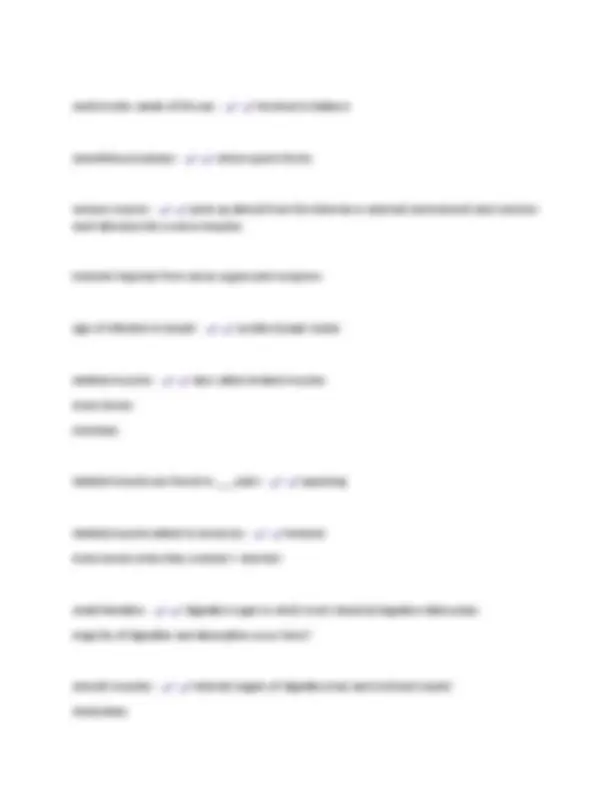
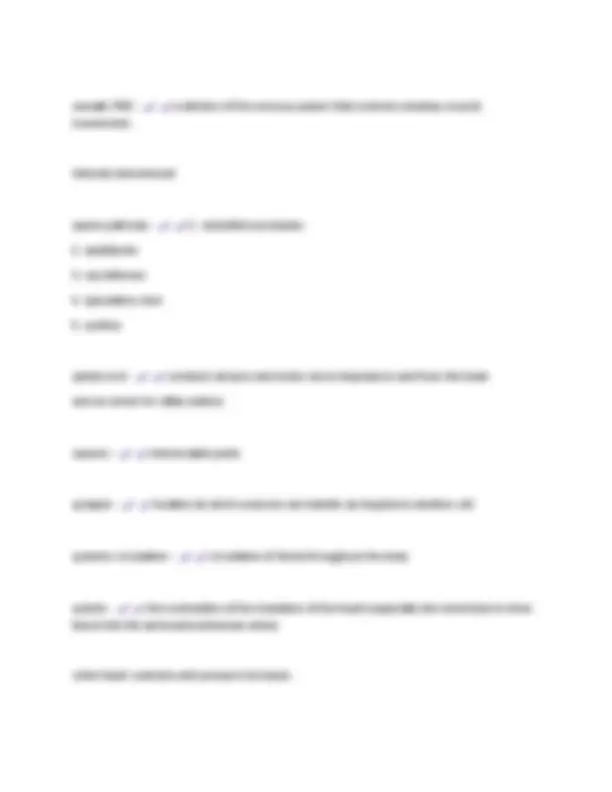
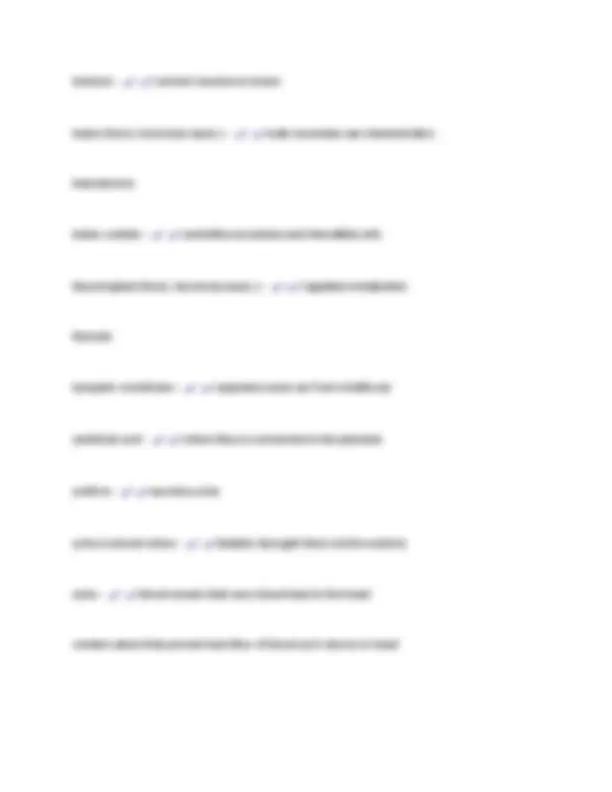
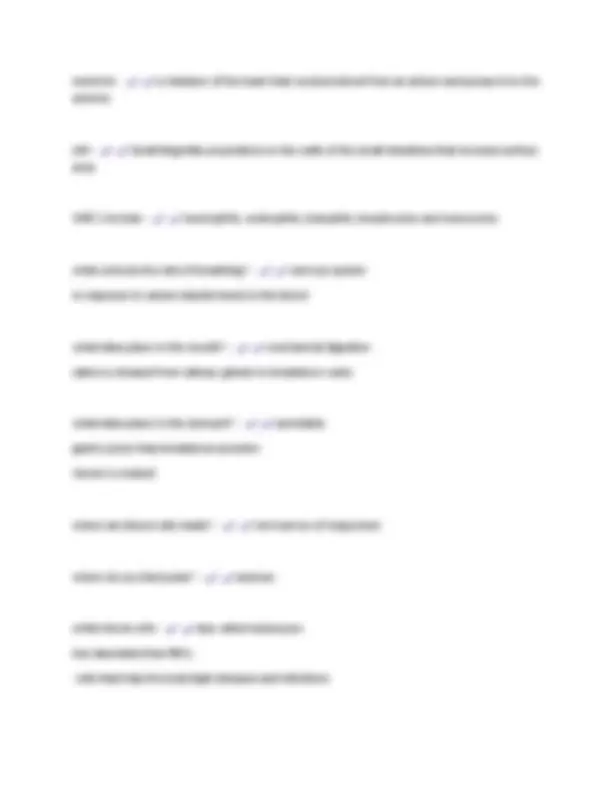



Study with the several resources on Docsity

Earn points by helping other students or get them with a premium plan


Prepare for your exams
Study with the several resources on Docsity

Earn points to download
Earn points by helping other students or get them with a premium plan
Community
Ask the community for help and clear up your study doubts
Discover the best universities in your country according to Docsity users
Free resources
Download our free guides on studying techniques, anxiety management strategies, and thesis advice from Docsity tutors
3 areas of the brain - cerebrum cerebellum medulla (brain stem) 3 types of muscle - cardiac smooth skeletal 3 types of neurons - sensory interneurons motor neurons accessory organs - of the alimentary canal. In the GI tract, organs that play a role in digestion but not directly part These include the liver, the gallbladder, the pancreas adrenal gland (funct, hormones assoc.) - f ight or flight hormone on the kidneys regulate water balance, BP and joint articulation adrenaline steroids (cortisone) aerobic respiration - Respiration that requires oxygen, sequentially releasing energy and storing it in ATP glucose is used to obtain energy OPPOSITE of photosynthesis aerobic respiration begins at the __ and ends at the __ - mitochondria after absorption, products of digestion goes to - alimentary canal - cytoplasm and ends in the blood and lymph
Typology: Exams
1 / 25

This page cannot be seen from the preview
Don't miss anything!


















3 areas of the brain - cerebrum cerebellum medulla (brain stem) 3 types of muscle - cardiac smooth skeletal 3 types of neurons - sensory interneurons motor neurons accessory organs - In the GI tract, organs that play a role in digestion but not directly part of the alimentary canal. These include the liver, the gallbladder, the pancreas adrenal gland (funct, hormones assoc.) - on the kidneys fight or flight hormone regulate water balance, BP and joint articulation adrenaline steroids (cortisone)
aerobic respiration - Respiration that requires oxygen, sequentially releasing energy and storing it in ATP glucose is used to obtain energy OPPOSITE of photosynthesis aerobic respiration begins at the __ and ends at the __ - cytoplasm and ends in the mitochondria after absorption, products of digestion goes to - blood and lymph alimentary canal - Also known as the gastrointestinal (GI) tract of the digestive tract, the alimentary canal is the long muscular "tube" that includes the mouth esophagus, somatch, small intesitne, and large intestine. carries out stages of digestive process (mechanical and chemical digestion and absorb ion) alveoli - tiny sacs of lung tissue specialized for the movement of gases between air and blood amylase - enzyme in saliva that breaks the chemical bonds in starches anaerobic respiration - Respiration in the absence of oxygen. This produces lactic acid less efficient anus - A muscular opening at the end of the rectum through which waste material is eliminated from the body
blood - type of connective tissue that is made up of a variety of cells suspended in liquid called plasma blood of embryo and mother are - never directly connected blood vessel function in bones - provide nutrients and oxygen take away wastes brain - located in the skull and controls most functions in the body brain stem includes - medulla oblongata and pons and midbrain and parts of the hypothalamus bronchi - The passages that branch from the trachea and direct air into the lungs bronchioles - small subdivisions of the bronchi that are dead ends with tiny air sacks called alveoli at the end capillaries - tiny blood vessels that connect arteries and veins walls allow materials to enter and leave blood carbohydrate (enzymes, end products and important locations) - 1. amylase, sucrase, maltase
cardiac muscles - only in heart involuntary cardiovascular system made up of - heart blood vessels blood cartilage - cushions bones at the joints cell body - largest part of a typical neuron; contains the nucleus and much of the cytoplasm cellular respiration - process by which we get energy from the food that we eat can be aerobic or anaerobic cerebellum - the "little brain" attached to the rear of the brainstem; it helps coordinate voluntary movement/ coordination and balance cerebrum - anterior largest portion of brain sight of complex/high level thinking conscious and voluntary actions controlled here chemical digestion - the digestion process in which enzymes are used to break foods into their smaller chemical buiding blocks
cornea - front of eye allows light to enter eye coronary circulation - circulation of blood to the heart damage to spinal cord - paralysis or other permanent damage (potentially) dendrite - extension of the cell body of a neuron that carries impulses from the environment or from other neurons toward the cell body receives impulse deoxygenated blood - blood that contains little oxygen (blue) diaphragm - Large, flat muscle at the bottom of the chest cavity that helps with breathing diarrhea is result of - peristalsis of feces through colon too quickly so water is NOT reabsorbed diastole - relaxation period, the widening of the chambers of the heart between two contractions when the chambers fill with blood when heart relaxes and pressure decreases diffusion during gas exchange between alveoli and capillaries - blood picks up the oxygen and carries it back to the heart
carbon dioxide is exhaled digestion - breaking down nutrients into small, soluble molecules that can be absorbed into the blood each RBC has ___ molecules of hemoglobin - 250 million ear is responsible for - hearing and balence egestion - Removal of undigested waste endometrium - unterine lining where egg develops enzymes - molecules, usually proteins or nucleic acids, that act as catalysts in biochemical reactions used in chemical reactions epiglottis - The flap of tissue that seals off the windpipe and prevents food from entering. esophagus - muscular tube that moves food from the pharynx to the stomach eustachian tube - where the middle ear opens to the pharynx equalizes pressure example of flexor and extensor muscles - biceps (flexor)
gallbladder - stores bile gametes - monoploid or haploid = half normal chromosomes gastric juice - chemically breaksdown proteins acidic (pH of 2) hemoglobin - iron-containing protein in red blood cells that carries oxygen for delivery to cells homeostasis - process by which organisms maintain a relatively stable internal environment hormones - chemical messengers bind to receptors and influencing the activity of the cell usually activated by a stimulus how do you test CO2 levels in exhaled air? - lime water ( turns cloudy) bromythymol blue (turns yellow) how gas exchange occurs during respiration (for blood to become oxygenated) - capillaries surround alveoli gas exchange occurs across alveolar membrane via diffusion
how long is the SI? - 6 meters how many bones make up human skeleton? - more than 200 humans digestion tube extends from - mouth to anus called alimentary canal hydrolysis - A chemical process that lyses, or splits, molecules by the addition of water; an essential process in digestion. if an egg is fertilized (process) - 1. uterus
lactic acid - when a muscle continues to burn sugar but doesn't have enough oxygen to do it properly and becomes sore large intestine - colon organ that removes water from the undigested materials that pass through it waste moves via peristalsis larynx - voice box contains vocal cords lens - focuses light onto the retina shape is changed by the attached muscles ligaments - connect bone to bone lipids (enzymes, end products, and important locations) - 1. lipases
lymph capillaries - Tiniest lymphatic vessels, Drains away fluid so that it does not accumulate in the tissues of our body. lymph nodes - bean-shaped organs varying in size found throughout the body; filter microorganisms and foreign materials from lymphocytes WBC's are present in the nodes and attack bacteria that may be present in the fluid male external genitalia - scrotum and penis male internal genitalia - testes male urethra - common to both reproductive and urinary sysems mechanical digestion - Part of digestion that uses movement and muscles to break down food into smaller pieces medulla - controls basic homeostatic functions (body temps, BP, breathing, act) menstruation - shedding process middle ear - vibrations produced by sounds are transmitted through the malleus, incus and stapes. pass through oval window enter inner ear
neurons have electrical potential due to - differences in sodium and potassium concentration across cell membrane neurotransmitter - chemical used by a neuron to transmit an impulse across a synapse to another cell oocyte - immature egg optic nervce - sends signals from eyes to brain osteoarthritis - degenerative none and joint disease osteocytes - hard calcium rich, extracellular matrix found in bone osteoporosis - disease caused by calcium loss affects older people and postmenopausal women outer ear - collects sounds and transmits them to the tympanic membrane ovarian follicles - inside ovaries, contain oocyte matures and enlarges as egg develops ovaries - primary reproductive organ
produce eggs and hormones ovaries (funct, hormones assoc.) - female secondary sex characteristics estrogen and progesterone ovulation - when an egg is mature and is released by the follicle occurs approx every 28 days oxygenated blood - blood that carries an abundant amount of oxygen pancreas - located partially behind the stomach in the abdomen, and it functions as both an endocrine and exocrine gland. It produces digestive enzymes as well as insulin and glucagon parathyroid gland (funct, hormones assoc.) - regulates calcium metabolism essential for proper bone formation parathormone peristalsis - involuntary waves of muscle contraction that keep food moving along in one direction through the digestive system pharynx - muscular tube at the end of the gastrovascular cavity, or throat, that connects the mouth with the rest of the digestive tract and serves as a passageway for air and food
nerves and sensory receptors responsible for transmitting info to and from CNS PNS divided into two branches - somatic and autonomic PNS positive feedback mechanism - homeostatic control mechanism that increases the stimulus to push the variable farther from its originial value protease - Enzyme that breaks down proteins protein (enzymes, end products and important locations) - 1. proteases
RBC - also called erythrocytes small and thin responsible for transporting oxygen do NOT have nuclei or mitochondria!!! RBC, WBC and platelets make up ____% of blood - 45% rectum - stores waste until egestion reflex arc - carries out simple, quick, automatic responses to certain stimuli defensive and do no involve brain retina - innermost layer of the eyeball contains rods and cones rheumatoid artritis - degenerative joint disease caused by autoimmune response rod cells - sensitive to light distinguish between black and white allow us to see at night saliva - contain amylase salivary glands - three pairs of exocrine glands in the mouth that secrete saliva